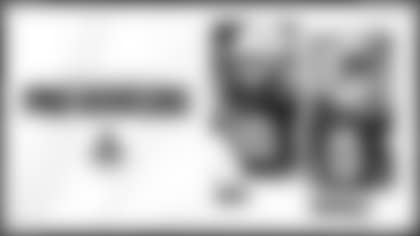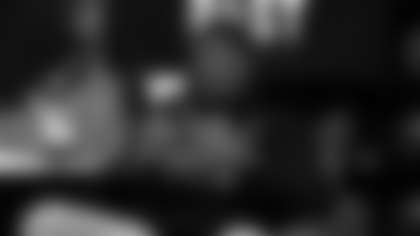HEAD COACH BILL BELICHICK
PRESS CONFERENCE
April 13, 2018
BB: Just will say a couple quick comments before we get to the draft. Since the last time we were together in Orlando – well, some of us – there have been a few changes to the roster on and off. That's pretty common; I mean, it's going on throughout the league. I'm sure there will be more of it over the course of the next four months, and we'll continue to do whatever we can to try to help and improve the football team in whatever way that is. You know, it's an exciting time of year, really. You know, we had free agency. I'd say there's a little bit of a lull in that, although it hasn't ended. Obviously, there's a lot of excitement with the draft coming up. Our players will be returning for the offseason program on Monday and we'll start to meet with them and then head into on-field work in May – end of April, early May – and then into OTAs. So, it's an exciting teambuilding time with the evaluation of new players, eventually new players coming onto the team, and watching our players come back. We have a number of guys, like we always do. There's always a lot of growth from year one to year two, but in the past we've had a number of players who have had a much bigger impact on the team in year two than they did in year one. This year, we have quite a few players who for one reason or another, various circumstances, didn't have a lot of production last year. That may change this year. I don't know, but it will be interesting and it's exciting to see how they're doing, as well. So, just kind of the whole process is coming together at this point in time. We've communicated with all of our current players, the new players, the players who were on the team from last year. We have the voluntary offseason program that starts on Monday. It will be heavily attended, but I know there are a couple players that I've talked to that have other commitments, but that's the way it always is, too. So, not really anything new there. And so that kind of brings us into the draft process here. This is the culmination of a tremendous amount of work by our scouting staff and to a lesser degree in the last couple months, our coaching staff and other people like that like myself. But Nick [Caserio], Monti [Ossenfort] and their respective staffs in the scouting area have done a tremendous job of accumulating a lot of information, putting a lot of things together to expedite the process for those of us like me that are coming into the draft a little bit later in the calendar after the regular season or after the conclusion of the postseason in this case. Starting with a couple thousand people and whittling that down to let's call it 500 and then getting our draft board down to a fraction of that size, but still the remaining players in the later rounds and free agents are a key part of the process, as well. As we know, we've had a lot of – every year we've had players undrafted that have made our roster. Some of them have been significant contributors – late-round picks, sixth, seventh-round picks, free agents – so that part of the process is critical to our success, in some ways just as important as the early rounds are. So, it's a big volume of players. A lot of work has gone into that. Again, Monti, Nick, their staff have done a great job. All that being said, it's surprising how every day you come in and kind of a new name pops up somehow – maybe not a new name but a significant change in a player's situation. You kind of think you're a week or two weeks before the draft and where did this guy come from? And then you go through the background and you dig through it and you sort of see why it's just surfacing now and why it didn't surface two months ago. But it's a constantly evolving situation. In the end, we give each player a value based on what we think he can do for us. And then we ultimately do the best we can to improve the football team with the opportunities that we have. This year is a little bit different than the last couple years. Going into those past two drafts, I would say we were able to eliminate a number of players just based on where we were selecting. This year is a little bit different than that, but we really need to know the draft from top to bottom and potentially – I'd say there's a handful of players that are probably out of reach – but realistically, just about everybody's in play, other than a handful of guys. So, that's a little bit different than what it's been. It doesn't change our process any; it just changes, I would say, the level of work that we do on some players that could be a factor that in other years, similar players, we scouted them but we really had no opportunity to draft them. But in the end, you can't manufacture players. You can't manufacture a guy. It's a name on the board right now and until that player gets on the field and performs, then we never really know for sure what that's going to be. So, really the time to evaluate the draft is a couple years afterwards, but we don't have that viewpoint right now, so we'll put it together and figure it out the best that we can, do what's best for the team, whatever that is. The schedule – so the preseason schedule was released and I noticed on that schedule that there are no games in May or June or July. Preseason games are in August, so it doesn't look like the regular season is going to start until September this year. So, that's four months of team building. There will be other player acquisitions and deletions, I'm sure, after the draft, as there always are with our team and every other team in the league. This is one piece of the puzzle, it's one part of the process, but there are no games scheduled in May. So, we'll continue to evaluate our team, all aspects of it – new players, new veteran players, new rookie players, existing players, players that will eventually come on the team from some other source at some point, as they always do or have in the past every year. So, we'll just go through that process and take it as it comes. But, it's an exciting time to be involved in the team building. We'll certainly add a number of names, players to our team in the next two weekends, so in the neighborhood of 20 players – whatever it ends up being – and that will be a big chunk of players. We'll see how it goes. Again, I'm sure there will be other parts of the team building as we go through the year. So, happy to take any questions relevant to the draft and do the best I can to help you with those. Also, I'd say this year has been probably a year where we've – there are always players in New England, but I'd say more players closer to home this year. Steve [Addazio], B.C. has done a great job of building that program, acquiring talent over there. They have a number of players. UCONN, UMass, Holy Cross, Maine – a lot of New England schools have guys that are going to be I would say factors in the draft at one time or another, so it's good to see that. It's made some local scouting – it's made that a little bit easier – not easy, but traveling is easier. So, not totally different, but it's a good group in this area this year.
Q: You referenced some of those guys that didn't play last season because of health or other reasons. With the understanding that every year is different, how do you balance their situations with some of your perceived draft needs this year?
BB: Well, again, the whole draft need thing is – I don't really understand that. You put a card up on the board. That doesn't mean the guy is a good player. I think it's important to acquire good players wherever they are. If you take a player at a position that you might so called "need" but he's not good enough to fill that need, then it's a wasted pick. So, I don't understand the whole need thing. I understand player value, and that's what we try to go by.
Q: Do you anticipate drafting a quarterback based on Tom Brady's age?
BB: We'll do what's best for the football team. We'll look at our opportunities and do what's best.
Q: How much longer do you anticipate he'll play?
BB: Yeah, again, I'm happy to answer the draft questions. I'm not going to get into everything else here.
Q: Two players you drafted last year, Derek Rivers and Antonio Garcia, didn't play. Do you almost look at them as an extension of this year's draft class?
BB: Yeah, as I said, the players almost always, pretty much without exception, improve from year one to year two. Some players had very little production in year one, guys like Trey Flowers, James White, Tom [Brady]. There are a number of players that fall into that category. We have players this year that were on the roster last year that didn't have a lot of production. We'll see how it goes this year. I don't know.
Q: You mentioned that you have more draft capital this year, as opposed to last year when you traded away several picks for more established players...
BB: And the year before.
Q: Sure. So, how do you go about deciding what course you want to take?
BB: We evaluate the players in the draft and we look at our opportunities. As those opportunities come closer, we evaluate what our options are and try to do what we feel like is best, whether that's stay and pick a player, move up for a player, move back and trade into next year. We've traded draft picks for players on the day of the draft; we did that last year. So, whatever the opportunities are, we'll evaluate them as they come and do what we think is best.
Q: What impresses you about this specific draft class in particular?
BB: I'd say we still have some work to do here. We're a couple of weeks away. I think we've accumulated – let's call it 99 percent of the information, 98 percent of the information – and now we really have to go back and kind of fine tune that, which it's a little easier to do when you have all of the information so you're not sitting there talking about, 'Well, these two guys but we really need to find out more about this guy before we can make that comparison.' I think we're approaching that point now, so when we get into early next week and we finalize some of the – like for example – this weekend is the medical recheck in Indianapolis. That'll affect some players. Some will get cleared up. Some may not get cleared up. So again, to try to make that evaluation today with information outstanding is kind of a waste of time because you're going to have to go back and do it again when new information comes in, especially when you know it's coming. Our process is kind of to get to that point, call it a week before the draft, and pretty much have all of the information in. There may be one or two morsels out there but for the most part that's in, and then start to spend probably the better part of that next week really trying to fine-tune our evaluations. I won't say it's easy, but I'd say it's relatively easy to take the guards and rank them one, two, three, four and five or take the corners and rank them one, two, three, four or five. When you start talking about the third guard and the second corner, the third guard and the eighth corner or however those grades line up, whether you're talking about players that are specialty type players that are role players that maybe are very good at a certain role but they're not three-down players. What are their values relative to other players who maybe are three-down players but at a lesser skill set? That's where it kind of gets tricky putting the whole board together. I'm not saying it's easy to rank the players in position in order, but that's a lot easier than trying to compare players at different positons, at different levels, guys who have played three or four years at high level conferences against the best players in college football versus other players who have played at lesser levels but are ascending players that are very talented players and trying to project how those values match up. That's the hard part, really.
Q: So do none of the incoming positions really jump out at you in this draft class?
BB: Well, again, we've pretty much seen all of the players. Again, the players that pop up now aren't players that are popping up in the second round. They're players that maybe weren't draftable, or we graded as not draftable players and maybe the player is draftable, or maybe we have a player that's draftable and then as we grind through it and all, this is really more of a free agent. I wouldn't say the guy comes from a guy we never heard of to being a second round pick. I'm not really talking about that, but there is some fluctuation based on new information, so we continue to assemble the information, try to make sure we know each player thoroughly, put a grade on them. But we have a number of players that have the same number of grades, and then there are other factors, for one reason or another, we put one player ahead of another. That's, I'd say, the upcoming process. That's where we're at.
Q: How much do you rely on your relationships with college coaches?
BB: Yeah, look, in the draft process I'd look at it like a jigsaw puzzle. It's got like 100 pieces. Each piece has a little bit of a fit, but in the end there are a lot of pieces. You have all of the factors that come with the player, a lot of other circumstances, other opinions. There's medical opinions, his ability as a teammate, leadership, work ethic, strength, quickness, level of improvement, rate of improvement, rate of decline, injury factors, versatility. How much has he done? How much could he do? Maybe he hasn't been asked to do it. There's a thousand things that go into it, so you try to put it all together and figure it out. It's hard. That's why it's a pretty imperfect process, but you do the best you can. I think this year, probably as we saw last year, somewhere between a half and two-thirds of the players in the first two round will be underclassmen. It's just less information on those guys. Every team in the league is working with the same information, but it's just less.
Q: How much do you still enjoying making the rounds at various colleges and networking with the coaching staffs?
BB: Yeah, I enjoy all of it. It's a good refresher. You go back and see where the college players are, what they're going through, what their process is. Our guys are past that. They're not training for the combine. They're training to play football. They know what the league is about. The players coming in to the league from college – some have a pretty good idea. I'd say some don't really have any idea what it's going to be and some are somewhere in-between. There's various levels of maturity, intelligence, experience, various levels of competition and so forth. It's a very imperfect process. All things weigh into it, some more than others. It would really just all depend on the individual player and circumstances. I couldn't say that this is the overriding factor. Some guys look good on film and they don't on workouts. Some guys look good in the workouts and they don't look good on film, vice versa. You just try to put it all together. The guys that do everything well – they'll probably be gone in the first five picks of the draft. They test well, that are smart, have a lot of production, that have upside. They've been high achievers for multiple years. Those guys are going to go early. That's a pretty short list. Then once you get past them, then there's various things you try to [evaluate]. Even with those guys there's certainly plenty of players picked at the top of the draft that haven't worked out. You just do the best that you can.
Q: Do you ever conduct mock drafts as part of the process to build a strategy during the draft?
BB: Sometimes we do that; yeah. Sometimes we do that. I'd say sometimes it just sparks a conversation. We might internally say, 'OK, how about player A and player B, player B and player C,' and if you did a mock draft, each guy kind of has a team. 'OK, it's your turn. You pick this guy.' And now you look at the board and, 'OK, it's our turn to pick and here's a scenario we hadn't really thought about. We didn't really picture that this guy would be there.' So that kind of can stimulate some – again, we don't know what the other teams are going to do and we don't know what we're going to do. Many of them probably don't know what they're going to do either. It would depend on what happens in front of them. Again, it's just an exercise to, I'd say, just kind of complete the process of preparation. That's the way it is on draft day, too. A lot of times you're sitting there looking at players that I thought this player would be there and he's long gone, or I didn't think this player would be there and he's still there. One of the problems with that is if you haven't done enough work on the player and he's still there but you really don't know the player as well as you should because you thought he wouldn't be there, then that puts you in a little bit of a dilemma. You're kind of in the unknown, which is where you don't want to be. It's hard enough when you think you know what you're doing. It's even harder when you're kind of guessing because you just didn't anticipate this. I'd say that's kind of the purpose of the mock draft. We don't sit around and do it all day, but we do it as an exercise just to kind of, as I said, stimulate.
Q: What have you seen from this year's quarterback draft class?
BB: Well, I'd say all of the positions are about the same. There are interesting players in every position. There's a wide range. Some guys have played more. Some guys have played less and different systems. In the end, again, you try to put the whole composite together for each individual player and put a value on him. It's the same thing for every position.
Q: How important are the roles of Moses Cabrera and the strength staff in the early part of this upcoming offseason program given the restrictions placed on the participation of the coaches?
BB: Yeah, well, I mean you know what the rules are. You pretty much answered your own question there. From a draft standpoint, other than the brief meeting time that we're allowed to have with the players in the offseason program, our coaches will be committed to working on remaining projects on the draft and preparing for OTA's and training camp.
Q: Have you noticed any changes in the draft now that the first round is kind of its own separate entity?
BB: Well, it's just the reset process, so really at the end of Day One you just reset your board as if this is the first round. The players that are gone, are gone. Then you reset it with the players that are there. Your scenarios change a little bit, obviously, because of the players that have been eliminated, probably most of whom you thought were going to be picked but there will be a couple that are still there, that are still on the board at the start of the second round that we might've thought wouldn't be on the board at the end of the second round. So now those players come into play and so why are they still there? Is it because of the player? Is it because of the circumstances that have put him there? Then you kind of take another look at wherever you're picking, what you feel like the scenario would be if you stay there or if you move up, if you move back. It's just a reset, and then when you get to the third day; it's the same reset process. I'd say relative to that, which is a good question, relative to that is the draft chart, which I'd say has been modified now to a certain degree because of the ability to trade compensatory picks. In the past those picks really, I wouldn't say don't have any value, but they didn't have much value because you couldn't do anything with them other than pick a player at that spot. Now that those picks are tradeable, that changes things a little bit because they are capital to move up, move back, or you could move into those spots or trade them for other players. When you add one pick in there, two picks in there, three picks in the third round – those are high round picks. But when you add, whatever it is, eight, 10, whatever picks in the sixth round, fifth round, it's a third of a round. I'd say the draft chart has been modified a little bit based on the change in that. One of the problems with the draft chart, if we all have our own draft charts, which is fine, sometimes it's hard to make a trade because, 'Well, my draft chart says this. Well, your draft chart says that,' whereas if we all use the same chart, we all agree on basic value. Then it's a lot easier to get what we call, I'd say, a fair trade, which I'd say over the last few years the majority of the trades that we've studied have been within a few percentage points one way or the other of being the correct value for the trade. In some cases in later rounds, sometimes those get a little bit skewed just because you have fewer picks. So if you don't have many picks to work with then you can only use the ones that you have, but a lot of times in the earlier round picks, a sixth round choice will get thrown in or given back or something like that to sort of balance out the value of the trade. I'd say, overall, in the last couple of years, as we've studied the trade values, they've been pretty consistent with what our evaluations show on the trade chart, which I think is what the majority of the teams use. Relative to resetting the draft, the trade chart, I'd say there's been a little bit of a modification there.













































